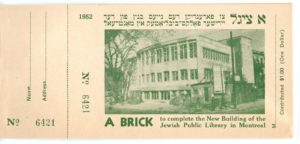In its beginnings, the Library was housed in apartments located near the Main (Saint-Laurent Boulevard), then the nerve center of Montreal’s Jewish community. Supported only by fundraising campaigns organized by its members, it then left the rented apartments to settle in its own premises.
Thanks to the dedication of its members, the Library constructed its own building in 1952. Designed by Harry Mayerovitch, a local architect and artist, the BPJ building required eight years of work, from the first fundraising campaign in 1945 to the he official opening of the institution in 1953. A true cultural center, the Library included an auditorium, an art gallery, meeting rooms, a concert hall and an art studio. The scale of this public building reflected the importance and vitality of the community.
 Located at the corner of avenue du Mont-Royal and avenue de l’Esplanade, the new library was close to the Young Men’s Hebrew Association, the Young Women’s Hebrew Association, Fletcher’s Field (now hui Jeanne-Mance Park), Hebrew Old People’s and Sheltering Home, as well as several synagogues and community organizations. At the heart of the new building, two stones commemorating the past and the future of the community were installed in strategic locations. The first, a fragment of a pillar from the Tłomackie synagogue in Warsaw, destroyed during the Holocaust, had been returned to the Library by the Polish authorities. Today, this fragment is kept at the Holocaust Memorial Center in Montreal, thanks to a long-term loan. The second stone, which came from Mount Zion,
Located at the corner of avenue du Mont-Royal and avenue de l’Esplanade, the new library was close to the Young Men’s Hebrew Association, the Young Women’s Hebrew Association, Fletcher’s Field (now hui Jeanne-Mance Park), Hebrew Old People’s and Sheltering Home, as well as several synagogues and community organizations. At the heart of the new building, two stones commemorating the past and the future of the community were installed in strategic locations. The first, a fragment of a pillar from the Tłomackie synagogue in Warsaw, destroyed during the Holocaust, had been returned to the Library by the Polish authorities. Today, this fragment is kept at the Holocaust Memorial Center in Montreal, thanks to a long-term loan. The second stone, which came from Mount Zion,
In the middle of the XX th century, the community gradually moves to the suburbs west of the city. In order to remain at the center of Jewish life, the Library sold its building and moved to a rented residence on Boulevard Décarie, before moving to its current location, on Chemin de la Côte-Sainte-Catherine.
